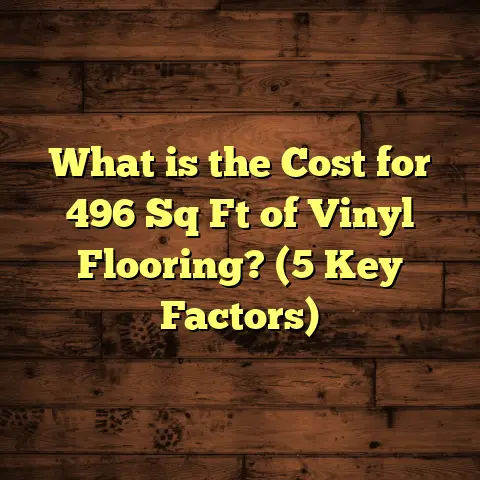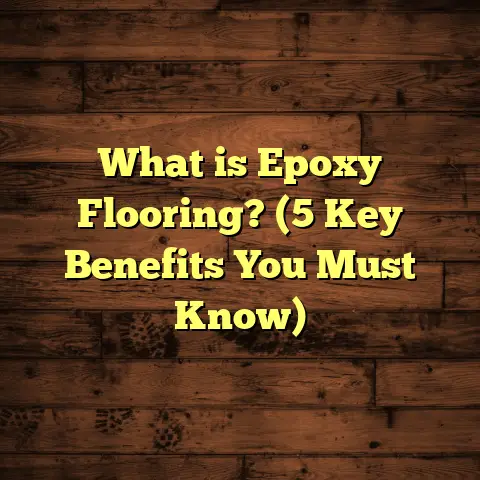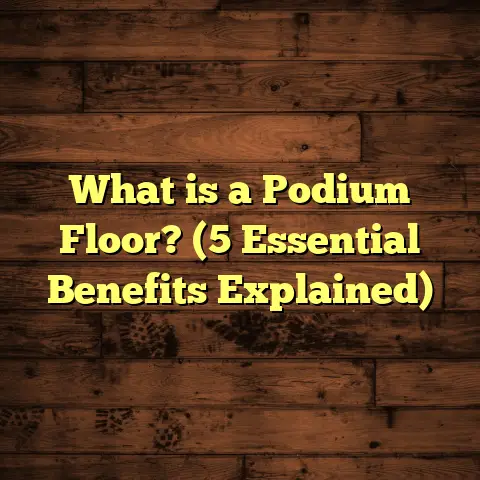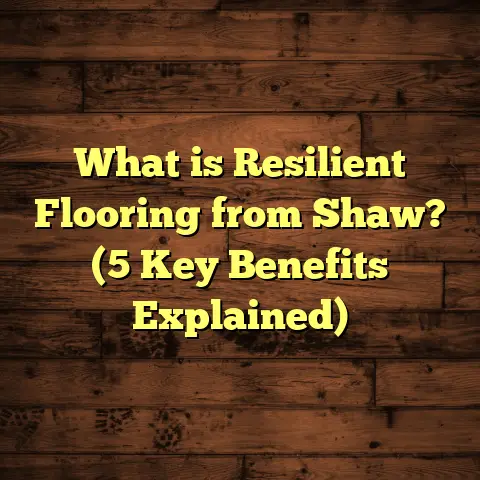What is Vinyl Flooring Also Known As? (5 Alternatives Revealed)
Vinyl flooring has stood the test of time. I mean, seriously—when you think about flooring options that have been around for decades and still remain popular, vinyl is right up there. It’s one of those materials that just keeps proving its worth, adapting to new trends and technologies without losing that core appeal of durability and affordability. I’ve been working with all kinds of flooring for years now, and vinyl always seems to be a reliable go-to for so many clients, whether they’re renovating a kitchen or outfitting a commercial space.
I remember early in my career, vinyl was often seen as the “budget” option. But today? It’s so much more than that. It’s stylish, versatile, and frankly, pretty impressive when you consider how far it’s come. If you’ve ever wondered what vinyl flooring really is or why it’s sometimes called by different names, you’re in the right place. I’m going to break this topic down in a way that feels like we’re just chatting over coffee—no jargon or confusion, just straightforward info and some stories from my own experience.
What is Vinyl Flooring?
Let’s start with the basics: what is vinyl flooring?
Vinyl flooring is a type of synthetic flooring material made primarily from polyvinyl chloride (PVC), combined with other compounds to create a flexible yet durable surface. It’s designed to be resilient—meaning it can handle pressure, traffic, and moisture without breaking down easily.
Vinyl can be produced in a few different formats:
- Sheets: Large rolls that are cut to size.
- Tiles: Square or rectangular pieces that snap or glue down.
- Planks: Often designed to look like hardwood boards.
One of the coolest things about vinyl is its ability to mimic more expensive materials like hardwood, stone, or ceramic tile without the high price tag or fragility. That’s because manufacturers use advanced printing technologies to create highly detailed surface patterns that look surprisingly real.
How Vinyl Flooring is Made
Understanding the manufacturing process helps me appreciate vinyl even more. The layers typically include:
- Backing Layer: Provides stability and support.
- Core Layer: Gives thickness and durability.
- Printed Design Layer: The “look” of the floor (wood grain, stone texture, etc.).
- Wear Layer: A transparent layer that protects against scratches, stains, and fading.
This wear layer is crucial because it determines how tough your floor will be over time.
I once worked on a project where the client was unsure about vinyl because they thought it might scratch easily. I explained how the wear layer works and showed them samples of different thicknesses. They opted for a thicker wear layer for their busy household with pets—and two years later, their floor still looks brand new.
Vinyl Flooring Types at a Glance
To give you a clearer idea:
| Format | Durability | Installation | Common Use |
|---|---|---|---|
| Sheet Vinyl | Moderate to High | Glue-down or loose lay | Bathrooms, kitchens |
| Vinyl Tiles | High | Glue-down or click-lock | Commercial spaces, kitchens |
| Vinyl Planks | High | Click-lock or glue-down | Living rooms, basements |
Why Does Vinyl Have So Many Names?
If you’ve ever asked about vinyl flooring at a store or online, you might have noticed it goes by different names. This can be confusing! But here’s the deal—each name usually refers to a specific type or style of vinyl flooring.
Here are five popular alternatives you’ll hear:
1. Luxury Vinyl Tile (LVT)
Let’s talk about LVT first because it’s become one of the most popular types of vinyl flooring in recent years.
LVT stands for Luxury Vinyl Tile. The “luxury” part might sound like marketing fluff, but it actually refers to the quality and design sophistication compared to older vinyl tiles. LVT is thicker than traditional vinyl and typically features enhanced textures and patterns that mimic natural stone or ceramic tile.
From my experience installing LVT in both homes and commercial spaces, it offers a fantastic balance between aesthetic appeal and practicality. For example, an office I worked on recently wanted the look of marble floors but needed something more budget-friendly and easier to maintain. LVT was perfect—it looked authentic, was easy to clean, and held up against heavy foot traffic.
Why Choose LVT?
- Realistic designs: Thanks to high-definition printing.
- Durability: Thicker wear layers mean longer lifespan.
- Waterproof: Great for moisture-prone areas.
- Comfort: Slightly softer underfoot than real tile.
LVT vs Traditional Tile
Many people assume tile means ceramic or porcelain only. But LVT provides similar visual appeal with fewer installation headaches—no grout lines that collect dirt or cracks that chip easily.
2. Vinyl Composite Tile (VCT)
Now here’s an older cousin of LVT that still holds strong in commercial settings: Vinyl Composite Tile (VCT).
VCT is made from a mixture of vinyl and limestone fillers. It’s tough and durable but has a different feel—more utilitarian and less textured than LVT.
I’ve installed VCT in schools and hospitals where cost-effectiveness and durability are top priorities. These tiles can handle heavy foot traffic but require regular waxing for upkeep because they don’t have a protective wear layer like LVT.
VCT Characteristics:
- Durability: Outstanding for high-traffic environments.
- Appearance: Typically solid colors or simple patterns.
- Maintenance: Needs frequent waxing/polishing.
- Cost: Usually less expensive than LVT.
Who Should Consider VCT?
It’s ideal when budget is tight but durability can’t be compromised—think community centers, retail stores, or healthcare facilities.
3. Sheet Vinyl
Sheet vinyl is probably what most people picture when they hear “vinyl flooring.” It comes in large rolls (usually 6 to 12 feet wide) and is installed as one continuous sheet.
This format drastically reduces seams, which makes sheet vinyl highly water-resistant—a major plus in bathrooms and laundry rooms where moisture is common.
I’ve installed sheet vinyl in plenty of bathrooms where clients loved the seamless look combined with easy cleaning.
Pros of Sheet Vinyl:
- Seamless installation: Limits water penetration.
- Wide variety: Patterns ranging from faux wood to abstract.
- Quick installation: Especially when professionally done.
- Affordable: Often less expensive per square foot than planks or tiles.
Potential Drawbacks:
- Can be tricky to repair if damaged (patches may be visible).
- Requires professional installation for best results to avoid bubbles/wrinkles.
- Less “natural” texture compared to LVT planks.
4. Rigid Core Vinyl Flooring
Rigid core vinyl is newer but gaining popularity fast because it combines benefits of vinyl with added structural stability.
These floors have a core made from materials like Stone Plastic Composite (SPC) or Wood Plastic Composite (WPC). This gives them rigidity that traditional vinyl lacks—meaning they resist dents better and don’t flex underfoot as much.
I installed SPC rigid core flooring in a basement renovation where moisture was a concern. The floor stayed flat and unbent despite humidity changes—something traditional vinyl would have struggled with.
Features of Rigid Core Vinyl:
- Stability: Strong core resists warping.
- Waterproof: Great for basements/kitchens.
- Installation: Usually click-lock systems make DIY easier.
- Sound insulation: Better than regular vinyl due to dense core.
Difference Between SPC and WPC?
- SPC has a mineral stone core—denser and harder.
- WPC has a wood-plastic core—softer underfoot but slightly less moisture resistant.
5. Resilient Flooring
This term is broader and includes any flexible flooring materials like vinyl, linoleum, cork, or rubber. When someone says “resilient flooring,” they often mean vinyl because it dominates this category in today’s market.
The defining trait? These floors bounce back after pressure instead of cracking or breaking like ceramic tile might.
Resilient floors have been popular because they provide comfort underfoot plus durability—perfect for kitchens where standing for long periods is common.
My Personal Experience with Vinyl Flooring Alternatives
After years working in both residential and commercial settings, I’ve had firsthand exposure to all these types. Each has its own strengths depending on project needs:
- I love recommending LVT when clients want upscale looks without hardwood prices.
- For budget projects that need toughness, VCT remains unbeatable.
- When moisture protection is critical, sheet vinyl or rigid core SPC are my go-tos.
- I’m always cautious about matching installation method with space conditions—poor prep can ruin even the best flooring material.
One memorable job involved replacing worn-out VCT in an elementary school cafeteria with LVT planks featuring wood visuals. The staff loved how warm it looked compared to cold tiles, plus cleanup was easier after lunchtime chaos.
Breaking Down Vinyl Flooring Benefits with Data
You might wonder how vinyl compares statistically with other floors across key factors such as cost, lifespan, maintenance, and customer satisfaction. Let me share some recent industry data from market research reports combined with my own observations:
| Factor | Vinyl Flooring | Hardwood Flooring | Laminate Flooring |
|---|---|---|---|
| Average Cost/Sq Ft | $2 – $7 | $5 – $15+ | $1 – $5 |
| Lifespan | 10 – 20 years | 20+ years | 10 – 15 years |
| Water Resistance | High (especially LVT & SPC types) | Low | Moderate |
| Maintenance Level | Low | Moderate | Low |
| Installation Ease | Moderate to Easy | Moderate | Easy |
| Popularity Growth | 4% annual growth (2010–2023) | Stable | Moderate |
I’ve found these numbers reflect what I see on the ground—the balance between affordability and performance keeps vinyl steadily growing in popularity worldwide.
Environmental Impact: What You Should Know
Vinyl flooring’s plastic base raises questions about sustainability. This has come up often during consultations with eco-conscious clients.
Here’s what I tell them:
- Traditional vinyl production involves fossil fuels and chemical processes.
- Newer products increasingly incorporate recycled PVC content.
- Some companies offer recycling programs for old vinyl flooring.
- Vinyl’s durability means fewer replacements over time, reducing waste overall.
To make an informed choice, look for certifications like FloorScore (indoor air quality) or ask about manufacturer sustainability policies.
Installation Tips from My Toolbox
Having installed hundreds of floors myself, I want to share some practical tips:
- Subfloor Prep Is Key
A smooth, clean subfloor will help your vinyl lay flat without bumps or gaps. - Choosing Installation Type
Click-lock planks are great for DIYers; glue-down sheets usually require pros. - Allow For Waste
Plan for about 5-10% extra material for cuts, mistakes, or pattern matching. - Transitions Matter
Use transition strips where vinyl meets other floors to prevent tripping hazards.
One time I helped a homeowner install sheet vinyl over an uneven plywood floor without leveling—it led to bubbles forming later on. Lesson learned!
How to Maintain Vinyl Floors for Longevity
Vinyl is low-maintenance but still benefits from good care:
- Use gentle cleaners; avoid abrasive scrubbing pads.
- Place felt pads under furniture legs.
- Clean spills promptly to prevent staining.
- Avoid steam cleaners—they can damage the wear layer.
A client once called me after using a steam mop on her new LVT floor—edges started peeling slightly! We fixed it by re-adhering edges but it was avoidable with proper care.
Comparing Vinyl Flooring Alternatives Side-by-Side
For quicker decision-making, here’s how these five alternatives stack up:
| Type | Cost Per Sq Ft | Durability | Water Resistance | Ease of Installation | Maintenance | Ideal Use Cases |
|---|---|---|---|---|---|---|
| Luxury Vinyl Tile | $3 – $7 | High | Excellent | Moderate | Low | Residential & commercial |
| Vinyl Composite Tile | $1 – $3 | Very High | Good | Moderate | High (waxing) | Schools, hospitals |
| Sheet Vinyl | $2 – $5 | Moderate | Excellent | Professional | Low | Bathrooms, kitchens |
| Rigid Core Vinyl | $3 – $8 | Very High | Excellent | Easy (click-lock) | Low | Basements, kitchens |
| Resilient Flooring | Varies | Varies | Varies | Varies | Varies | Broad category including above |
What About Cost Over Time?
Besides upfront price, think about long-term costs like maintenance and potential replacement:
- Vinyl’s resistance to scratches and water reduces repair costs.
- Some cheaper vinyl may show wear sooner; investing in thicker wear layers pays off.
- Compared to hardwood’s refinishing needs or tile grout cleaning expenses, vinyl often wins on value over time.
A Final Word From Someone Who’s Seen It All
Vinyl flooring isn’t just “vinyl.” It comes in many forms tailored for different needs—from luxurious wood-look tiles to rugged commercial squares. Knowing these alternatives helps you choose smarter based on your home or business requirements.
Personally, I find working with vinyl rewarding because it meets so many client needs: budget-friendly options with high-end looks; floors tough enough for kids and pets; easy installations that save time; and designs diverse enough to suit any style.
If you’re thinking about updating your floors or advising someone else on theirs, remember these alternative names—they’ll help you ask the right questions at the store or online. And if you want tips on installation or care specific to your project, just ask—I’m always happy to share what I know!
Have you tried any type of vinyl floor? What worked well? What didn’t? Let’s talk about your experiences—I learn a lot from every story!
(End of article.)





